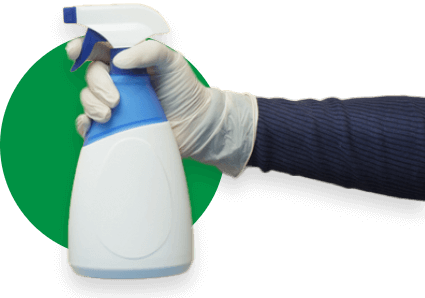Is your office experiencing a mysterious uptick in employee complaints about headaches, fatigue, or respiratory issues? You may be experiencing Sick Building Syndrome (SBS), a common issue in commercial spaces that significantly affects productivity and well-being. The good news is that professional commercial cleaning services offer a powerful weapon in this fight. We target the root causes of SBS, creating a more productive environment for your employees.
Is Your Building Making People Sick? Understanding Sick Building Syndrome
You’ve observed the symptoms: constant headaches, unexplained fatigue, or persistent respiratory issues plaguing your team while at work, but mysteriously disappearing once they leave the office. These recurring health and comfort issues, directly linked to time spent in your building, define Sick Building Syndrome (SBS). We often cannot pinpoint a specific, singular illness or cause. Still, the pattern of symptoms appearing and then subsiding with proximity to the building points to an environmental factor.
While various complex factors contribute to SBS, poor indoor air quality is a primary driver. This includes the presence of chemical pollutants, biological contaminants, and inadequate ventilation. It also manifests as persistent or unpleasant odors; eliminating office odors is a step to improving indoor air quality.
SBS affects more than just comfort; it also impacts productivity, increases absenteeism, and can harm your bottom line. That’s where professional cleaning services step in, not with a mop and bucket but with a plan to restore wellness to your workspace.
4 Most Common Causes of Sick Building Syndrome
At Dallas Janitorial Services, we believe in being open about what makes your building a ground zero for germs and how we can help. Let’s pull back the curtain and look at what’s going on behind those symptoms, as Sick Building Syndrome doesn’t emerge from a single culprit; instead, a complex interplay of environmental factors within a building often creates the conditions for it to thrive.
Unpacking these contributing elements is the first step toward effective removal and proactive prevention. We identify these factors, understand how they accumulate, and discover how they ultimately impact employee health. These typically fall into several interconnected categories, each demanding a focused approach to neutralize their threat:
Chemical Contaminants
One major contributor to Sick Building Syndrome is the presence of Volatile Organic Compounds (VOCs). These are chemical vapors from common office materials, including cleaning agents, freshly applied paints, newly installed carpeting, and even everyday office furniture.
While small, dispersed amounts of VOCs may pose minimal risk, the situation escalates drastically in an environment with poor ventilation. These volatile organic compounds can quickly accumulate in a well-sealed office environment, resulting in a considerable build-up.
As these concentrations rise, they may impact the indoor air quality of your environment and provoke various adverse health effects among those present. Typical symptoms include headaches, nausea, irritation, eye, nose, and throat discomfort.
Biological Contaminants
Buildings, especially those with high humidity or water damage, become breeding grounds for various biological contaminants. These include mold, bacteria, viruses, and dust mites. Pests also introduce allergens and pollutants. These biological agents trigger allergic reactions, asthma attacks, and other respiratory illnesses, often leading to what people sometimes call building-related illness.
Inadequate Ventilation
You may love your sleek, energy-efficient building. After all, it is a modern design meticulously crafted to maximize every kilowatt and minimize drafts. Unfortunately, modern city architecture often inadvertently creates a breeding ground for poor indoor air quality. While commendable for energy conservation, the quest for airtight construction can backfire dramatically when Heating, Ventilation, and Air Conditioning (HVAC) systems fail to deliver an adequate supply of fresh outdoor air.
Inadequate ventilation leads to trapping and recirculating a cocktail of indoor pollutants. Think of it as perpetually breathing the air already breathed, a stagnant atmosphere devoid of the invigorating qualities of fresh, clean air. This is not merely an unpleasant inconvenience; it’s akin to living in a sealed ecosystem, a fishbowl where the water hasn’t been changed, and where the buildup of waste products gradually poisons the environment.
Other Factors
Beyond chemical irritants, a building’s environment can significantly impact occupant health. Lighting quality, temperature fluctuations, and humidity levels are crucial in creating a comfortable and healthy space.
Glaring lights can cause eye strain and headaches, while inconsistent temperatures can lead to discomfort and irritability. Moreover, excessively dry or humid environments can exacerbate respiratory issues and create an atmosphere conducive to mold growth.
While these factors are not the primary causes of Sick Building Syndrome, they can contribute to and intensify its symptoms. When the environment is compromised, even minor issues with lighting or temperature can add stress and further diminish occupant well-being.
How to Fight Sick Building Syndrome: The Role of Professional Cleaning
Professional cleaning services play a pivotal role in combating Sick Building Syndrome. We directly address indoor pollutant sources, helping to eliminate building-related illnesses. Unlike surface-level tidying, a professional approach goes deep to eliminate contaminants and improve office indoor air quality.
Here’s how professional cleaning tackles the causes of SBS:
- Removing dust, allergens, and contaminants: Expert cleaners utilize specialized equipment and techniques to remove dust, pollen, pet dander, and other airborne allergens from all surfaces, including hard-to-reach areas.
- Reducing chemical residues: We use appropriate cleaning solutions and proper rinsing techniques, minimizing the residue of harsh chemicals that contribute to indoor air pollution.
- Improving hygiene: Thorough disinfection of high-touch surfaces, restrooms, and kitchen areas significantly reduces the spread of bacteria and viruses, crucial for preventing building-related illness.
- Addressing specific problem areas: Professionals identify and treat areas prone to mold growth, water damage, or pest infestations, preventing them from becoming primary contaminant sources.
- Using green or low-VOC cleaning products: Many commercial companies prioritize eco-friendly, low-VOC (volatile organic compound) cleaning products. These products are less likely to off-gas harmful chemicals, directly contributing to air quality improvement for a healthier environment.
- Implementing tailored cleaning schedules: Regular, consistent cleaning is key. Professional services develop customized schedules that meet your office’s unique needs, ensuring ongoing cleanliness and preventing pollutant buildup.
7 Cleaning Strategies to Combat Sick Office Syndrome
Combating Sick Building Syndrome demands more than just a superficial tidy-up; it requires a strategic, in-depth approach that targets the underlying causes of poor indoor environments. Professional cleaning goes beyond aesthetics, actively neutralizing the threats that make a building “sick.” We don’t just clean for appearance; we clean for health, employing precise methods and advanced tools to eliminate hidden contaminants.
Here are some key strategies and services that directly combat SBS, transforming your workspace into a truly healthy and productive space:
1. Regular Dusting and Vacuuming
This isn’t just about appearances. High-efficiency particulate air (HEPA) filter vacuums are essential for capturing microscopic dust particles, allergens, and other airborne contaminants contributing to poor indoor air quality.
2. Proper Restroom Sanitation
Restrooms are hotbeds for bacteria and viruses. Comprehensive cleaning and disinfection of all surfaces, fixtures, and floors are important for preventing the spread of illness.
3. Carpet and Upholstery Cleaning
Carpets and upholstered furniture act as filters, trapping dust, dirt, allergens, and mold spores. Regular deep cleaning and extraction are necessary to remove these embedded pollutants.
4. Addressing Water Intrusion
Professional cleaners identify and report signs of water leaks or dampness, primary precursors to mold growth. Prompt action is crucial to avoid widespread mold contamination.
5. Air Vent and Duct Cleaning
Dust, allergens, and mold accumulate within your building’s HVAC system. Regular cleaning of air vents and ducts ensures that clean air circulates throughout the office, improving overall air quality.
6. Using Low-VOC Cleaning Products
Low-VOC cleaning products are a cornerstone of fighting SBS. These products achieve excellent cleaning results without introducing new chemical contaminants into the indoor environment.
7. Implementing Cleaning Schedules
A consistent and comprehensive cleaning schedule tailored to your building’s needs is vital for proactively preventing SBS. A proper cleaning schedule ensures that pollutants are regularly removed before they accumulate and impact occupants.
Find Your Solution to Sick Building Syndrome
If your office experiences the tell-tale signs of Sick Building Syndrome, the solution lies in proactive and professional intervention. Professional cleaning services equip us to identify, target, and eliminate the key sources of pollutants, leading to significant air quality improvement and a healthier indoor environment. Investing in comprehensive office cleaning services prevents SBS’s negative impacts, boosts employee well-being, and ensures a more productive and pleasant workspace. This approach also helps eliminate office odors and generally improves office air quality.
Are you concerned about Sick Building Syndrome in your office? Contact us for a custom cleaning consultation to address the root causes and promote a healthier workspace.
Sick Building Syndrome FAQs
What is the main cause of sick building syndrome?
Poor indoor air quality often causes sick building syndrome. Inadequate ventilation and chemical and biological contaminants like VOCs, mold, and bacteria within the building primarily contribute to this.
What are the three symptoms of sick building syndrome?
Three common symptoms of sick building syndrome are headaches, fatigue or lethargy, and irritation of the eyes, nose, or throat. Other symptoms include dizziness, nausea, and difficulty concentrating, which often improve when people leave the building.
How do you get rid of sick building syndrome?
Address the root causes to eliminate sick building syndrome effectively. Improve ventilation, eliminate chemical and biological contaminants through professional cleaning, repair water damage, and implement consistent, high-standard cleaning protocols for lasting indoor air quality improvement.







